 |
|
 |
|
From the Norwegian name for the Arctic Char (Salvelinus alpinus).
The type section is defined as the interval from 1745.4 m to 1623.5 m in well 7128/6-1 located on the Finnmark Platform (Fig. 53). The base of the formation is there characterised by a marked increase in the gamma ray log response, and a corresponding decrease in both density and interval transit time based on the density and sonic logs. This represents the transition from tight limestones of the underlying Isbjørn Formation to silicified deposits in the basal part of the Røye Formation (Fig. 54).
Fig. 53. Well logs of the type section of the Røye Formation in 7128/6-1.
For explanation of symbols see Fig. 3.
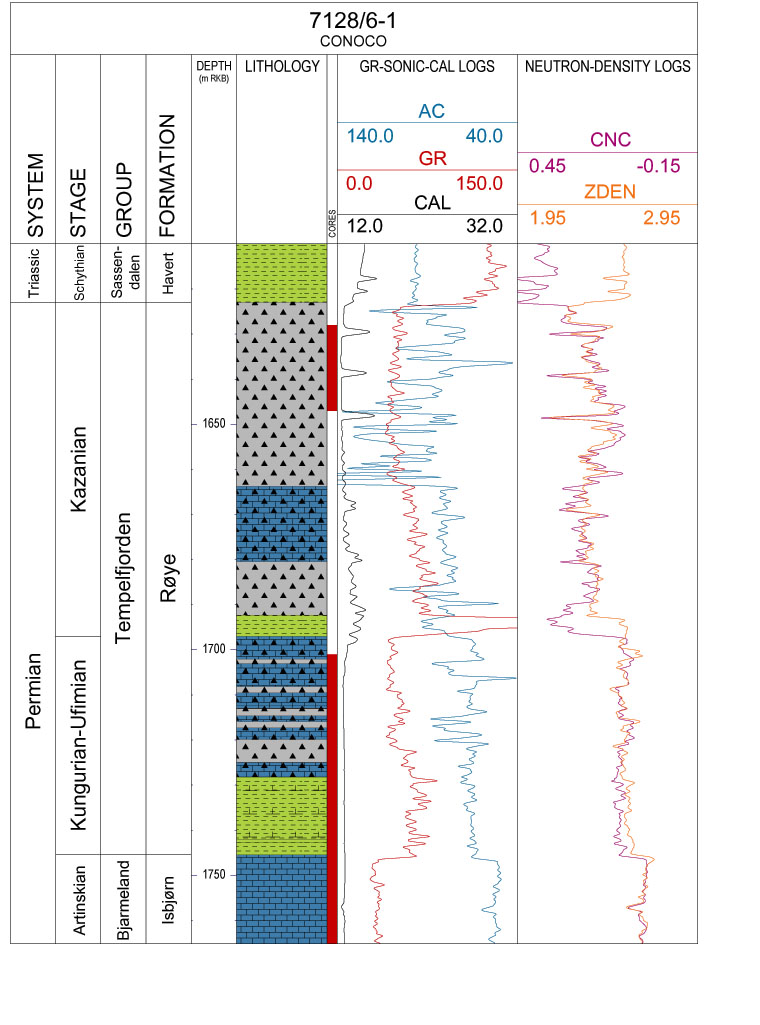
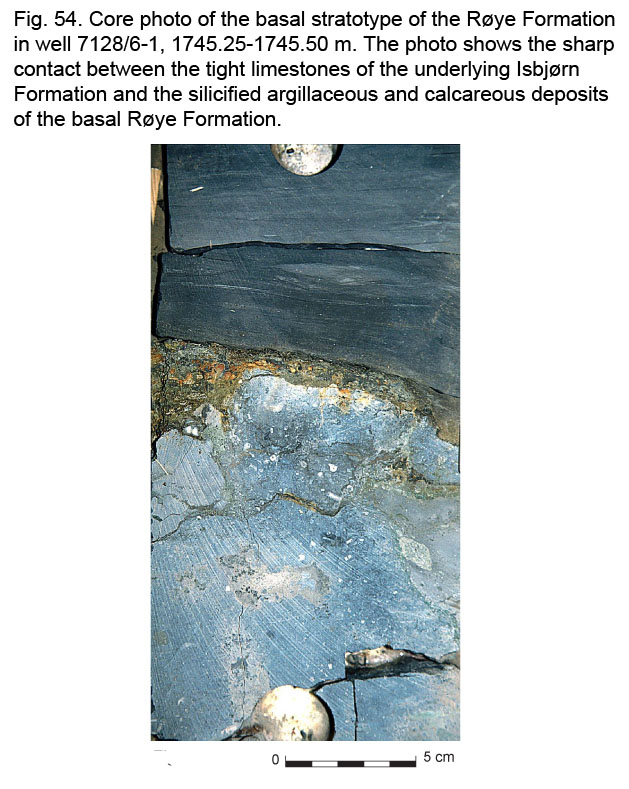
Reference sections:
Reference sections are defined:
In Loppa High well 7120/1-1, with formational base at 2997 m on the Ulv Formation; this well shows an interfingering of the Røye and Ørret formations, with typical Røye lithofacies occurring from 2997 m to 2604 m and from 2458 m to 2430 m (Fig. 51, Fig. 55),
In Loppa High well 7121/1-1 with formational base on the Isbjørn Formation at 3502 m and direct contact with Triassic shales at 2993 m (Fig. 56),
In 7228/9-1 from 4065 m to 3966 m on the northern margins of the Finnmark Platform (Fig. 57), resting on the Isbjørn Formation.
In well 7120/1-1, the formational base at 2997 m is characterised by a slight increase in both gamma ray and sonic log response (Fig. 55). This well’s interfingering of the Røye and Ørret formations shows that the transition from the Ørret back into the Røye Formationb at 2458 m displays a marked decrease in both gamma ray response and density, reflecting the transition back from silicified fine-grained siliciclastics to limestone.
Fig. 55. Well logs of the reference section of the Røye Formation in 7120/1-1.
For explanation of symbols see Fig. 3.

Fig. 56. Well logs of the reference section of the Røye Formation in 7121/1-1 in the scale 1:1000.
For explanation of symbols see Fig. 3.

Fig. 57. Well logs of the reference sections of the Røye and Ørret formations in 7228/9-1.
For explanation of symbols see Fig. 3.
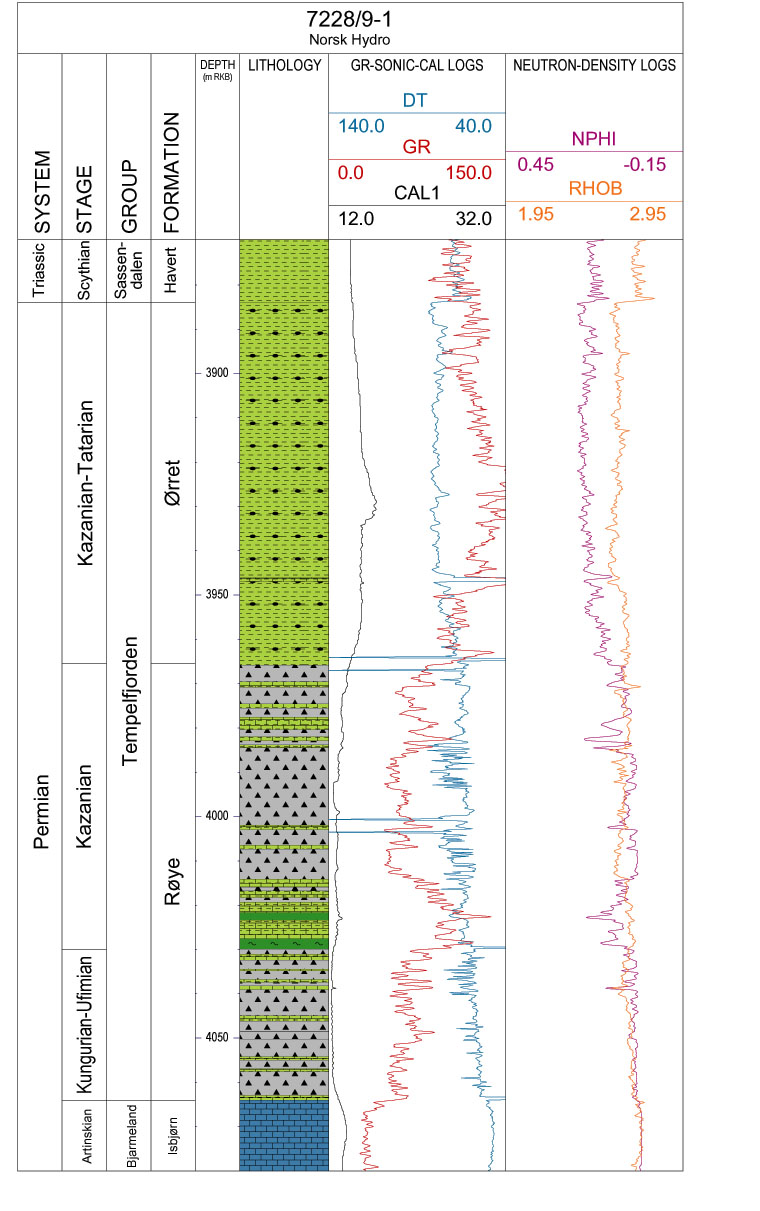
The formation is 122 m thick in the type well 7128/6-1 on the central Finnmark Platform. It thins to 19 m in core 7128/12-U-01 further to the south. Along the northern margins of the platform, the formation is 99 m thick in well 7228/9-1S and less than 70 m thick in 7229/11-1. It thickens north of the Nordkapp Basin to 230 m in 7124/3-1 on the Bjarmeland Platform and to its thickest development of 509 m in reference well 7121/1-1 on the southeastern Loppa High; 421 m of Røye Formation occur in the interfingering development found in 7120/1-1 further west on the high. Our tentative interpretations of wells 7120/12-2 and 7120/12-4 on the southern margins of the Hammerfest Basin suggest a very complex interfingering of possible Røye and Ørret Formation representatives, the former showing a total of up to about 150 m in several intercalations (Fig. 58); more data are however needed from this area to confirm this interpretation.
Fig. 58. Well logs of the Upper Palaeozoic succession in 7120/12-2 from the Hammerfest Basin.
For explanation of symbols see Fig. 3.

Silicified sediments dominate the Røye Formation as the result of early silicification processes that were sourced by abundant silica sponge spicules. On the eastern Finnmark Platform, the lower part of the Røye Formation consists of dark grey to black, silicified calcareous claystone with minor pyrite and traces of organic material (e.g. 1745,4 to1728 m in well 7128/6-1; Fig. 54). The lithology of the lower part of the formation changes somewhat toward the Loppa High where it is characterised by interbedded silicified marls, silty carbonate mudstone and calcareous claystone with some thin beds of spiculitic cherts (e.g. 3177 to 2860 m in well 7120/1-1). The relative proportion of these facies varies laterally and spiculitic chert dominates well 7228/9-1 (4064-4014 m) whereas the basal part of the formation in well 7121/1-1 (3502-3367 m) is dominated by silicified silty carbonate mudstone.
The upper part of the formation consists of interbedded spiculite, spiculitic chert, silicified bioclastic, bryozoan-dominated limestone (wackestone to grainstone), silicified carbonate mudstone, silicified marl and calcareous claystone (e.g. 3367 to 2993 m in 7121/1-1, 3800 to 3671 m in 7124/3-1 and 1688 to 1569 m in 7128/4-1). The silicified limestone is best developed on the Loppa High (reference wells 7120/1-1 and 7121/1-1) and on the eastern Finnmark Platform (7128/4-1, 7128/12-U-01 and 7129/10-U-01, Fig. 59). The spiculitic deposits show variable clay and dolomitic lime mud content. These rocks are mainly tight, with no apparent porosity; however, on inner parts of the Finnmark Platform white to light grey porous spiculites are present in wells 7128/4-1, 7128/6-1 and 7128/12-U-01 (Fig. 60, Fig. 61) – the porosities apparently reflecting secondary solution processes.
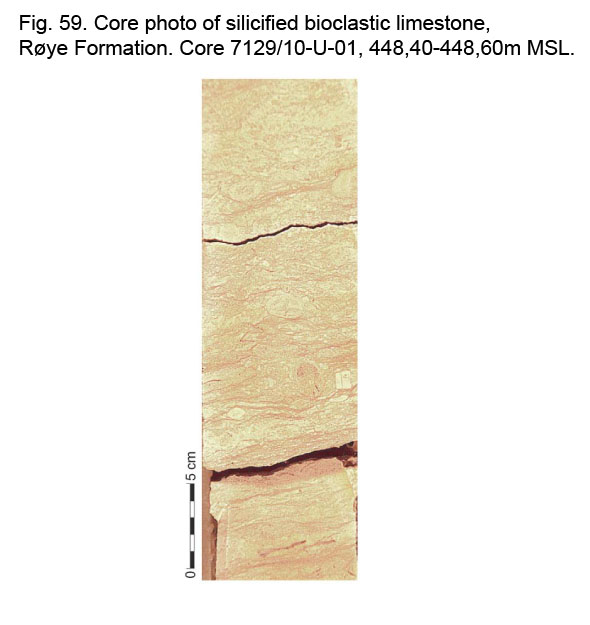
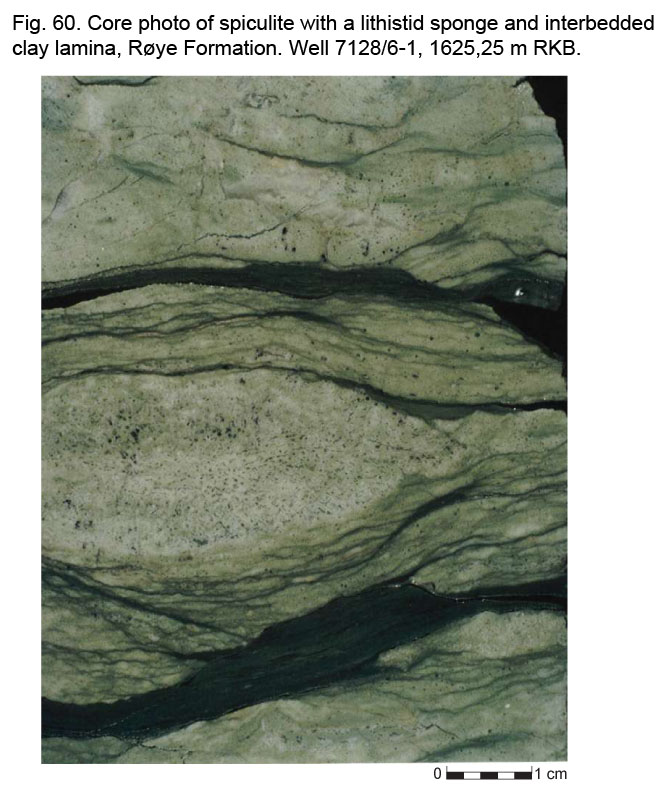
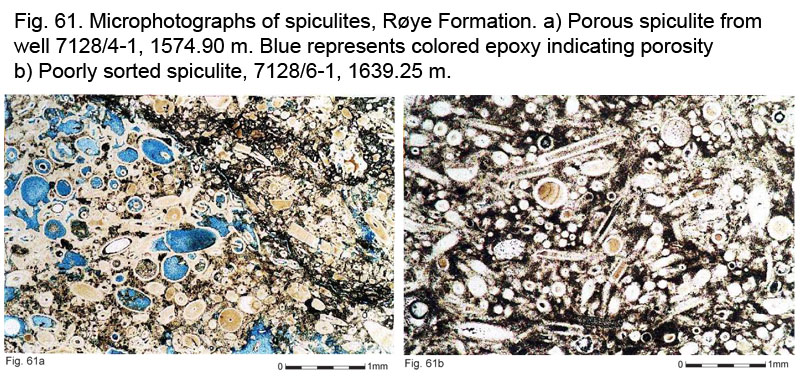
The formation forms a laterally continuous unit at the base of the Tempelfjorden Group from the eastern Finnmark Platform and westward to the Loppa High. In the southern Hammerfest Basin the formation is less clearly developed, but as mentioned above, our interpretation suggests several units, each 30 to 100 m thick, interbedded with sediments herein assigned to the Ørret Formation. The Røye Formation thins toward the east and updip on the Finnmark Platform. Local thinning is also seen above carbonate buildups of the underlying Bjarmeland Group (see e.g. well 7229/11-1, Fig. 51).
Cores from 7128/12-U-01 and 7129/10-U-01 suggest a ?Kungurian to Kazanian – (?Tatarian) age (Mangerud 1994; Bugge et al. 1995).
The lower part of the formation represents distal marine, low-energy deep shelf to basinal conditions established during and after major initial transgression. On the Loppa High and inner parts of the Finnmark Platform bryozoan-dominated, low relief carbonate platforms prevailed. The middle to upper parts of the formation represent distal marine, moderate to deep shelf conditions affected by periodic high-energy storm episodes which reworked the sediments, but with a normal depositional environment characterised by a very rich siliceous sponge fauna. Carbonate ramps were still situated on the Loppa High and inner parts of the Finnmark Platform.
On the Loppa High in well 7121/1-1 the upper part of the formation reflects initial transgression with deposition of deep shelf spiculites succeeded by carbonate platform deposits. Towards the crest of the Loppa High the formation was truncated by late Permian uplift and erosion.